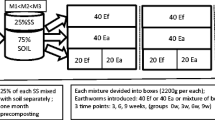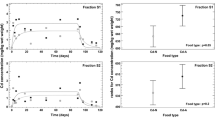Summary
The lead content of whole earthworms, highest in contaminated site specimens, was significantly higher inDendrobaena rubida thanLubricus rubellus and a species difference in zinc was also recorded. Selective feeding and differential absorption are discounted and a species difference in maximum tolerance to body lead is suggested. Copper was low in all specimens. Chloragocytes and intestinal tissue showed significantly higher lead levels in contaminated earthworms than in control material. Ultrastructurally, chlorgocytes from contaminated earthworms showed electron dense flecks associated with the chroragosome peripheries and within the debis vesicles. Very fine flecks occurred in the nuclei, but mitochondria and Golgi were indistinguishable from control material. Preliminary X-ray microanalysis of contaminated chloragocytes revealed lead and phosphorus. The deposits within the chloragocytes might represent unbound lead precipitated by phosphate buffer; flecks being absent from contaminated, citrate buffered material and from control material. The chloragosomes are proposed as possible sites for sequestered lead.
Chloragocyte and intestinal glycogen levels were significantly higher in control material where the chloragocyte cytoplasm was rich in α-glycogen rosettes, these being absent from lead contaminated cells. The glycogen-lead correlation suggests that the metabolism of contaminated chloragocytes is directed towards lead sequestration, though differing nutritional states cannot be ignored.
Similar content being viewed by others
References
Allcroft, R., Blaxter, K.L.: Lead as a nutritional hazard to farm livestock. V. The toxicity of lead to cattle and sheep and an evaluation of the lead hazard under farm conditions. J. comp. Path. Ther.60, 209–218 (1950)
Gish, C.D., Christensen, R.E.: Cadmium, nickel, lead and zinc in earthworms from roadside soil. Environ. Sci. Tech.7, 1060–1062 (1973)
Goyer, R.A.: The renal tubule in lead poisoning. I. Mitochondrial swelling and aminoaciduria. Lab. Invest.19, 71–77 (1968)
Goyer, R.A., Krall, A., Kimball, J.P.: The renal tubule in lead poisoning. II. In vitro studies of mitochondrial structure and function. Lab. Invest.19, 78–83 (1968)
Goyer, R.A., Leonard, D.L., Moore, J.F., Rhyne, B., Krigman, M.R.: Lead dosage and the role of the intranuclear inclusion body. Arch. environm. Hlth20, 705–711 (1970)
Gruden, N., Stantić, M.: Transfer of lead through the rats intestinal wall. Sci. Total Environ.3, 288–291 (1975)
Hogg, T.W.: Immunity of some low forms of life from lead poisoning. Chem. News71, 223–224 (1895)
Ireland, M.P.: Result of fluvial zinc pollution on the zinc content of littoral and sub-littoral organisms in Cardigan Bay, Wales. Environ. Pollut.4, 27–35 (1973)
Ireland, M.P.: Variations in the zinc, copper, manganese and lead content ofBalanus balanoides in Cardigan Bay. Wales. Environ. Pollut.7, 65–75 (1974)
Ireland, M.P.: Metal content ofDendrobaena rubida (Oligochaeta) in a base metal mining area. Oikos26, 74–79 (1975a)
Ireland, M.P.: Distribution of lead, zinc and calcium inDendrobaena rubida (Oligochaeta) living in soil contaminated by base metal mining in Wales. Comp. Biochem. Physiol.52B, 551–555 (1975b)
Ireland, M.P.: The effect of the earthwormDendrobaena rubida on the solubility of lead, zinc and calcium in heavy metal contaminated soil in Wales. J. Soil Sci.26, 313–318 (1975c)
Ireland, M.P.: Lead retention in toadsXenopus laevis fed increasing levels of lead contaminated earthworms. Environ. Pollut.12, (In press)
Lowry, O.H., Rosebrough, N.J., Farr, A.L., Randall, R.J.: Protein measurement with Folin-phenol reagent. J. biol. Chem.193, 265–275 (1951)
Mierau, G.W., Favara, B.E.: Lead poisoning in roadside populations of deer mice. Environ. Pollut.8, 55–64 (1975)
Pearse, A.G.E.: Histochemistry. Theoretical and applied. London: Churchill Livingstone 1972
Piearce, T.G.: The calcium relations of selected Lumbricidae. J. anim. Ecol.41, 167–188 (1972)
Reynolds, E.S.: The use of lead citrate at high pH as an electron-opaque stain in electron microscopy. J. Cell Biol.17, 208–213 (1963)
Roe, J.H., Dailey, R.E.: Determination of glycogen with the anthrone reagent. Anal. Biochem.15, 245–250 (1966)
Roots, B.I.: Nature of chloragogen granules. Nature (Lond.)179, 679–680 (1957)
Roots, B.I.: Some observations of the chloragogenous tissue of earthworms. Comp. Biochem. Physiol.1, 218–226 (1960)
Schroeder, H.A., Tipton, I.H.: The human body burden of lead. Arch. Environm. Hlth17, 965–978 (1968)
Škreb, Y., Habazin-Novak, V.: Reversible inhibition of DNA, RNA and protein synthesis in human cells by lead chloride. Toxicology5, 167–174 (1975)
Thiéry, J.P., Rambourg, A.: Cytochimie des polysaccharides. J. Microscopie21, 225–232 (1974)
Vallee, B.L., Ulmer, D.D.: Biochemical effects of mercury, cadmium and lead. Ann. Rev. Biochem.41, 91–128 (1972)
Van Gansen, P.S.: Physiologie des cellules chloragogènes d'un lombricien. Enzymologia20, 98–108 (1958)
Van Gansen, P.S., Vandermeerssche, G.: L'ultrastructure des cellules chloragogènes. Bull. Micr. Appl.8, 7–13 (1958)
Van Hook, R.I.: Cadmium, lead and zinc distributions between earthworms and soil: Potentials for biological accumulation. Bull. Environ. Contam. Toxicol.12, 509–511 (1974)
Walker, G., Rainbow, P.S., Foster, P., Crisp. D.J.: Barnacles: possible indicators of zinc pollution? Mar. Biol.30, 57–65 (1975a)
Walker, G., Rainbow, P.S., Foster, P., Holland, D.L.: Zinc phosphate granules in tissue surrounding the midgut of the barnacleBalanus balanoides. Mar. Biol.33, 161–166 (1975b)
Author information
Authors and Affiliations
Additional information
The assistance of Mr. P.M. Webster, University of Keele, is gratefully acknowledged.
Rights and permissions
About this article
Cite this article
Ireland, M.P., Richards, K.S. The occurrence and localisation of heavy metals and glycogen in the earthwormsLumbricus rubellus andDendrobaena rubida from a heavy metal site. Histochemistry 51, 153–166 (1977). https://doi.org/10.1007/BF00567221
Received:
Issue Date:
DOI: https://doi.org/10.1007/BF00567221




